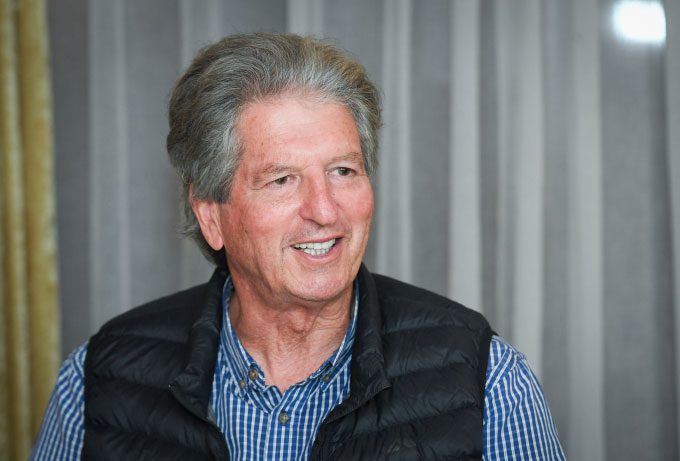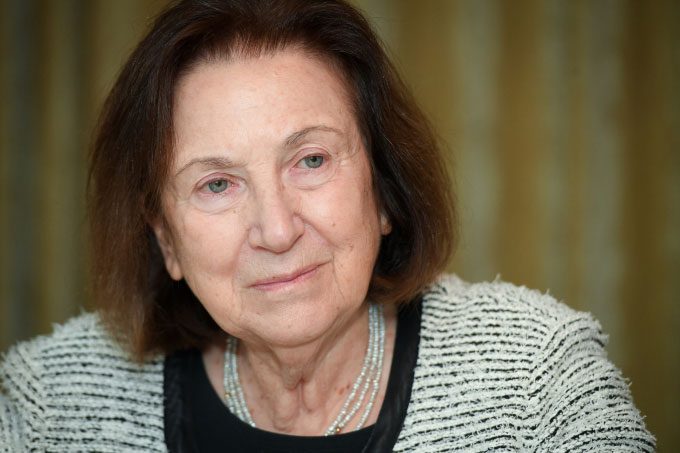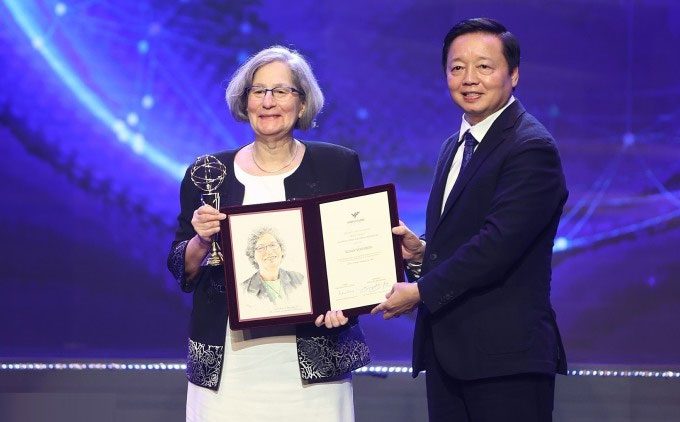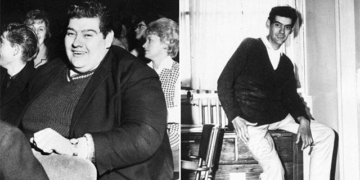11 scientists were honored for their pioneering research related to high-yield rice varieties, ozone layer depletion, solar panels, lithium-ion battery storage, diabetes, and obesity.
1. Solar Panel Technology
The VinFuture Grand Prize, the largest award (3 million USD), was awarded to 4 scientists for their groundbreaking invention, establishing a sustainable foundation for green energy through solar panel production and lithium-ion battery storage.
Among them, Professor Martin Andrew Green from the University of New South Wales, Australia, is a pioneer in the development of passive emitter and rear contact (PERC) technology for solar panels. Professor Martin has held the record for silicon solar panel efficiency for 30 of the last 39 years and is described as one of the ten key milestones in the history of photovoltaic technology.

Professor Martin Green. (Photo: Văn Lưu).
The improvement of solar panel efficiency has opened a new era of effective renewable energy production, contributing to a fair and sustainable world. Silicon solar panel technology has been developed by many scientists around the world for decades. However, modern high-efficiency solar panels rely on the passive emitter and PERC technologies pioneered by Professor Martin Green’s team.
Green was the first to describe and his team was the first to develop, experimentally proving two fundamentally different approaches to improve silicon cell efficiency. His research team significantly enhanced solar panel efficiency, paving the way for wider solar energy usage. Improvements include reducing photon energy loss by using reflective mirrors at the rear surface, combining dielectric layers and thin metal layers to reduce photon absorption. Additionally, they developed passive rear surface techniques using dielectric layers or heterostructures to reduce wave loss. These innovations have led to significant advancements in PERC technology, optimizing solar panel efficiency and demonstrating the feasibility of integrating these advanced technologies into mass production.
2. Creation of Lithium-ion Batteries
The VinFuture Grand Prize was also awarded to Professor Stanley Whittingham from Binghamton University, State University of New York, USA, along with two other scientists: Professor Rachid Yazami from Morocco and Professor Akira Yoshino from Japan, for their groundbreaking work on lithium-ion batteries.
This type of battery has laid the foundation for a wireless and fossil fuel-free society, providing significant benefits for humanity. Thanks to this research, together with the late American professor John B. Goodenough, Professors Akira Yoshino and Stanley Whittingham became recipients of the 2019 Nobel Prize in Chemistry.

Professor Stanley Whittingham, recipient of the Nobel Prize in Chemistry 2019. (Photo: Văn Lưu).
Professor Whittingham invented the operating principle of lithium-ion batteries and identified the role of lithium ions as an effective charge carrier. He initiated and discovered the operating principle of lithium-ion batteries. Starting from a breakthrough in 1974, he created the first lithium-ion battery, ushering in a new era in energy storage. He pioneered the research on intercalated electrodes and meticulously described the diffusion of lithium into various metal crystal lattices. Whittingham also focused on improving structural stability and cycle life of the batteries by applying multi-electron intercalation reactions to enhance their stability and capacity.
Since entering the market in 1991, lithium-ion batteries have powered some of the most widely used devices today, from laptops to smartphones. The development of lithium-ion batteries has also made electric vehicles viable and significantly boosted wireless communication.
3. High-Yield Rice Varieties Resistant to Brown Planthopper
Together with Professor Gurdev Singh Khush, an Indian-American, Professor Võ Tòng Xuân from Can Tho University was awarded a special prize for scientists from developing countries. The award honors his fundamental research in inventing and disseminating disease-resistant rice varieties, contributing to global food security. He is the first Vietnamese scientist to receive the VinFuture award.

Professor Võ Tòng Xuân. (Photo: Văn Lưu).
In the agricultural revolution, Professor Xuân played a crucial role in popularizing the IR36 rice variety across regions frequently attacked by pests in the Mekong Delta and collaborating with farmers to apply advanced transplanting techniques. Thanks to these initiatives, he has enhanced access to quality rice seeds and increased rice yields at lower costs without using harmful chemicals.
By the 1980s, the IR36 variety was used globally, with a cultivation area of up to 11 million hectares. By 2000, the widespread dissemination of IR36 and other rice varieties significantly contributed to rice yield increases, reaching 600 million tons. In addition to IR36, the IR64 variety has been widely cultivated on over 10 million hectares within two decades of its release, positively impacting the lives of millions around the world. IR64 was first disseminated in the Philippines in 1985, followed by Bhutan, Burkina Faso, Cambodia, China, Ecuador, Gambia, India, Indonesia, Mauritania, Mozambique, Vietnam, and the Sahelian regions of West Africa. By 2018, IR64 and its descendants were widely cultivated in many countries and became the most popular rice variety in tropical Asia, demonstrating their superiority and exceptional adaptability.
4. Discovery of GLP-1 Hormone for Weight Loss and Diabetes Treatment
The year 2023 witnessed an explosion of metabolic regulating drugs such as Ozempic, Wegovy, and Mounjaro. These medications are based on GLP-1 hormone, which can reduce both the risk of diabetes and cardiovascular diseases. Targeting GLP-1 receptors also supports effective weight loss. The discovery of the GLP-1 hormone earned a special award for Professor Jens Juul Holst from the University of Copenhagen, Denmark, for his research in new fields.

Professor Jens Juul Holst. (Photo: Văn Lưu).
Professor Holst is a pioneering scientist in the fields of endocrinology and metabolism. Alongside Professor Joel Habener’s research group at Massachusetts General Hospital, Professor Holst’s team at the University of Copenhagen discovered the structure and role of glucagon-like peptide-1 (GLP-1) in regulating gastrointestinal motility and insulin levels. The discovery of GLP-1 in the intestines and pancreas of mammals in 1986 led to his groundbreaking publication a year later on identifying the functional isoform of GLP-1, which is 7 amino acids shorter, denoted as proglucagon 78-107 or GLP-1 (7-36).
The identification of the GLP-1 (7-36) isoform subsequently led to the discovery of this peptide’s role in regulating insulin and glucose in humans, opening an era of diabetes and obesity treatments based on GLP-1.
Not only has he made significant contributions to identifying the biological role and developing GLP-1-based therapies, but Professor Holst has also played a key role in determining the activity of dipeptidyl-peptidase-4 (DDP-4) enzyme in the degradation of GLP-1. From this discovery, a new class of drugs based on DDP-4 inhibition mechanisms was developed, significantly improving the efficacy of GLP-1 therapies by enhancing the drug’s longevity in the body and increasing their stability and biological efficacy.
This award was also given to Associate Professor Svetlana Mojsov from Rockefeller University, USA, for her groundbreaking contributions to discovering functional isoforms of glucagon-like peptide-1 (GLP-1), leading to a series of research and development of therapies based on this peptide. While working at Massachusetts General Hospital in 1986, Ms. Mojsov collaborated with researchers to discover a range of GLP-1 isoforms, including GLP-1 (1-37), GLP-1 (1-36), GLP-1 (7-37), and GLP-1 (7-36), which could only be achieved thanks to her efforts in isolating specific antibodies for this peptide.

Associate Professor Svetlana Mojsov. (Photo: Văn Lưu)
In the same year, she also announced foundational research in the development of the field when she discovered GLP-1 (1-37) in the stomachs of mice. Later, in 1987, she continued to collaborate with Professor Habener and Dr. Gordon Weir to publish the first observations regarding the insulin-stimulating effects of GLP-1 (7-37) in a mouse pancreatic model. The discoveries made in identifying the physiological and endocrine roles of GLP-1 by Professor Svetlana Mojsov laid the groundwork for drug development efforts and clinical trials utilizing GLP-1 to combat obesity and diabetes, opening up opportunities to improve the health of hundreds of millions of people worldwide.
5. Discovery of the Mechanism Behind Ozone Hole Formation
The special award for Female Scientist was presented to Professor Susan Solomon from the Massachusetts Institute of Technology, USA—a pioneering scientist in the field of atmospheric chemistry, with groundbreaking contributions that expanded humanity’s understanding of ozone layer depletion and the role of chlorofluorocarbons (CFCs).

Deputy Prime Minister Tran Hong Ha presents the award to Professor Susan Solomon on the evening of December 20 in Hanoi. (Photo: Giang Huy).
Originating from calculations by Professors Mario Molina and Sherwood Rowland in 1974, the hypothesis regarding the impact of CFCs on the ozone layer garnered widespread scientific interest and research over the years. However, it was not until 1986-1987 that this hypothesis was convincingly proven after Professor Solomon’s experiments in Antarctica collected reliable evidence of a particularly large ozone hole caused by CFCs in this region. The experiments also confirmed her earlier hypotheses about the high density of stratospheric clouds in Antarctica creating an electromagnetic attraction to CFCs.
These experimental research results subsequently spurred global efforts and led to the establishment of the Montreal Protocol. This is one of the most successful international agreements in addressing global environmental issues, achieving worldwide consensus to phase out harmful substances like CFCs that deplete the ozone layer.
Additionally, Solomon’s extensive discoveries have enriched understanding of climate dynamics, focusing on areas such as atmospheric chemistry, climate feedback mechanisms, and human-induced impacts on global temperatures. Her insights and leadership have shaped scientific models and international policy, making significant contributions to global environmental protection efforts.
The award initiated by the VinFuture Foundation in 2020 is presented annually for groundbreaking scientific and technological inventions with the potential to create meaningful change in human lives. After three seasons, 27 scientists have been honored. The total prize amount is $4.5 million, including a main award of $3 million and three special awards of $500,000 each, with three categories: Female Scientist, Scientist from Developing Countries, and Scientist researching New Fields. VinFuture 2023 received 1,389 nominations from 90 countries and territories across five continents. This number was 970 in the second season and 599 in the first season. |


















































